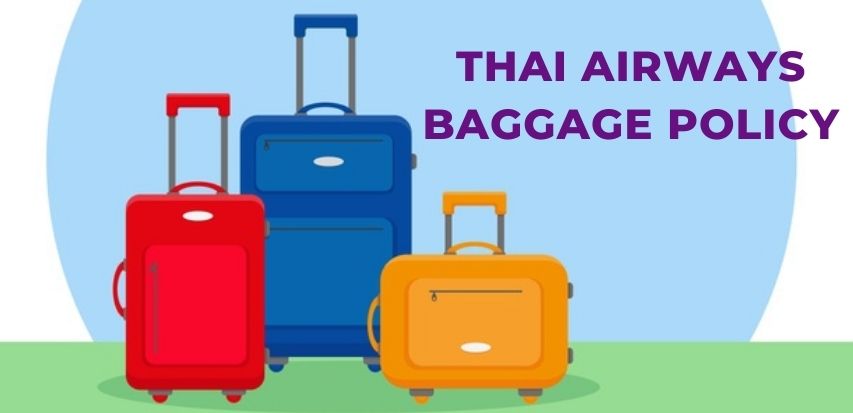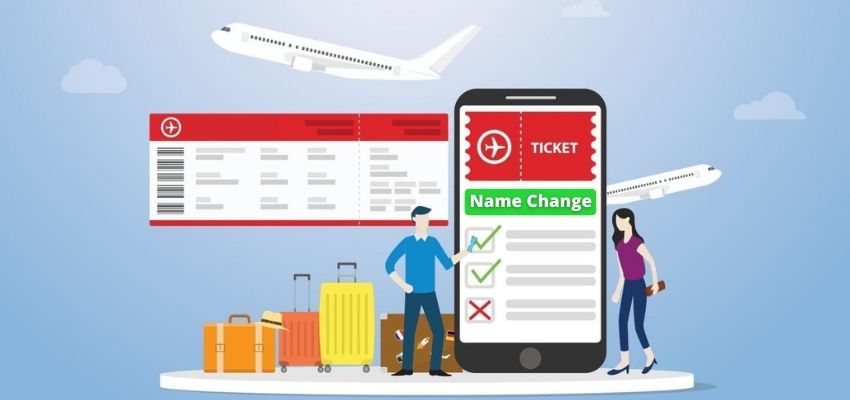Understanding the Thai Airways baggage policy by the passengers is crucial before flying with Thai Airways as it helps to understand how much one can carry along with them. As every airline has a different set of rules for baggage permit, the Thai Airways baggage allowance can be understood by going through the Thai Airways baggage policy below:

The Thai Airways Checked Baggage policy:
Thai airways has a different checked baggage policy for passengers who are traveling internationally and domestically. The baggage allowance also varies on the basis of travel class.
Thai Airways checked baggage allowance for Domestic Flight
Passengers on the basis of weight (maximum combined weight)
- Royal Silk Class passengers are allowed a maximum combined weight of all pieces totaling 40 kg (88 pounds).
- Economy Plus passengers have a maximum combined weight allowance of 35 kg (77 pounds).
- Economy Class passengers are permitted a combined weight allowance ranging from 20 to 35 kg (44 – 77 pounds)*.
- Infants not occupying a seat are allowed a maximum combined weight of all pieces totaling 10 kg (22 pounds).
- ROP Silver Members flying on TG sectors only are entitled to an additional allowance of +10 kg (22 pounds).
- ROP & Star Alliance Gold Members enjoy an additional allowance of +20 kg (44 pounds).
- Royal Orchid Platinum Members flying on TG sectors only have an additional allowance of +30 kg (66 pounds).
Allowance for Checked baggage Thai Airways for the International flight
Passengers traveling within TC3 (Asia, Australia, New Zealand), between TC2 (Europe, Africa, Middle East) and TC3 (Asia, Australia, New Zealand) on the basis of weight (combined maximum weight):
- Royal First Class passengers are entitled to a maximum combined weight of all pieces totaling 50 kg (110 pounds).
- Royal Silk Class passengers have a maximum combined weight allowance of 40 kg (88 pounds).
- Economy Plus passengers can avail themselves of a maximum combined weight of all pieces totaling 35 kg (77 pounds).
- Economy Class passengers have a combined weight allowance ranging from 20 to 35 kg (44 – 77 pounds), varying according to the class type: Saver Class 20 kg, Standard Class 25 kg, Flexi Class 30 kg, and Full Flex Class 35 kg.
- Infants not occupying a seat are allowed a maximum combined weight of all pieces totaling 10 kg (22 pounds).
- ROP Silver Members flying on flights operated by TG enjoy an additional allowance of +10 kg (22 pounds).
- ROP & Star Alliance Gold Members flying on flights operated by TG have an additional allowance of +20 kg (44 pounds).
- Royal Orchid Platinum Members flying on flights operated by TG have an additional allowance of +30 kg (66 pounds).
- Passengers traveling in Saver Class are allowed a maximum combined weight of all pieces totaling 20 kg.
- For Standard Class passengers, the maximum combined weight allowance is 25 kg.
- Flexi Class passengers have a combined weight allowance of up to 30 kg for all pieces.
- Passengers traveling in Full Flex Class can enjoy a maximum combined weight allowance of 35 kg for all pieces.
Thai Airways check in baggage allowance for International flight
Passengers traveling to or from the USA and Canada
- Passengers traveling in First Class (Royal First) are permitted a maximum weight of 32 kg (70 lbs) per baggage, with a maximum of 2 checked bags, each not exceeding a total dimension of 158 cm (62 inches).
- Similarly, passengers in Business Class (Royal Silk) can also carry up to 32 kg (70 lbs) per baggage, with a maximum of 2 checked bags, each within a total dimension of 158 cm (62 inches).
- Economy Class passengers are allowed a maximum weight of 23 kg (50 lbs) per baggage, with a maximum of 2 checked bags, each not surpassing a total dimension of 158 cm (62 inches)
- Infants not occupying seats are entitled to a maximum weight of 23 kg (50 lbs) per baggage, with a maximum of 1 checked bag, with a total dimension not exceeding 115 cm (45 inches)
Note: For basic regulations, please refer the official website of Thai Airways
Thai Airways Excess Baggage Policy:
Often passengers traveling get in the need of excess baggage due to last minute changes or more baggage requirements. The Thai Airways excess baggage must undergo evaluation and is subject to charges prior to the passenger’s boarding of the plane. The checked baggage allowance may vary based on factors such as cabin class, status level, military status, itinerary, and date of purchase. Any baggage exceeding the free baggage allowance is charged accordingly, irrespective of the passenger’s paid class or utilized class. The excess baggage charge rates, applicable for checked baggage on purely Thai Domestic sectors, are determined by the Weight Concept and are fixed as listed below.
| THB per Kilogram (Between…and.) | Bangkok | Chiang Mai |
| Chiang Mai | 60 | – |
| Chiang Rai | 70 | – |
| Hat Yai | 80 | – |
| Khon Kaen | 55 | – |
| Krabi | 70 | – |
| Phuket | 70 | 125 |
| Surat Thani | 65 | – |
| Ubon Ratchathani | 60 | – |
| Udon Thani | 55 | – |
- The charge for excess baggage is THB (Thai Baht) per kilogramme.
- For any extra THAI Domestic services, the excess baggage charge per kilogramme is equivalent to 1.5 percent of the highest standard direct one-way economy class cost.
- The offer or discount price for children and infants do not apply.
- Excess Baggage Charge rates for international travel are displayed separately in US dollars (USD).
- The excess luggage during check stages of journey is imposed based on zoning if baggage is checked from TG Domestic to TG International sectors.
Note:
- The aforementioned “Excess Baggage Charge (Within TC3, Between TC2 and TC3) Table” is applicable for checked portions from September 1, 2018, until further notice.
- The excess baggage charge rate is applied per kilogram for travel between Zone 1 and Zone 5.
- Discounted rates for children and infants are not available.
- For travel to/from Zone 6 (USA/Canada), the excess baggage charge rate is based on the Piece Concept. For detailed information, please consult the “Excess Baggage Charges (To/From USA/Canada)”.
- When baggage is checked through from TG Domestic to TG International sectors, the excess baggage charge for the through check portion is determined based on zoning. TG Domestic Sectors within Thailand are categorized under Zone 1. (Please refer to Zoning Definitions for the International Excess Baggage Charge Table.)
- Currency Conversion: Excess baggage charges denominated in USD will be converted to the local currency using the Banker’s Selling Rate on the date of baggage charging.
Zoning definitions for Thai Airways excess baggage price:
The excess baggage charge rate for checked portions of travel within TC3,
between TC2 and TC3, operates on a zone basis in the Weight Concept, effective on or after September 1, 2018. These rates are listed below.
Zone 1 comprises of Cambodia, Bangladesh, China (Kunming), Malaysia, Laos, Myanmar, Thailand and TG Domestic Sectors in Thailand, Singapore, Vietnam, Between Hong Kong and Taipei,Between Karachi and Muscat, Between Taipei and Seoul, Between Phuket and Singapore, Between Phuket and Kuala Lumpur
Zone 2 comprises of Brunei Darussalam, China (Beijing, Shanghai, Chengdu, Guangzhou, Xiamen, Chongqing, Changsha), Hong Kong, India, Indonesia, Macau, Nepal, Philippines, Sri Lanka, Taiwan, Between Hong Kong and Seoul, Between Phuket and Hong Kong, Between Phuket and Beijing
Zone 3 comprises of Australia (Perth), Bahrain, Japan, Korea, Oman, Pakistan, United Arab Emirates, Iran, Saudi Arabia, Between Phuket and Seoul, Between Phuket and Perth, Between Phuket and Taipei
Zone 4 comprises of Australia (Sydney, Brisbane, Melbourne), Egypt, Israel, Madagascar, Turkey, Russia (Moscow), Between Phuket and Sydney
Zone 5 comprises of Austria, Belgium, Denmark, Czechoslovakia, Finland, France, Hungary, Germany, Italy, New Zealand, Norway, Poland, Portugal, South Africa, Spain, Sweden, Switzerland, United Kingdom, Between Stockholm and Phuket, Between Copenhagen and Phuket, Between Frankfurt and Phuket, Between London and Phuket, Between Paris and Phuket, Between Zurich and Phuket, Between Munich and Phuket
Zone 6 comprises of Canada and United states of America
| USD per Kilogram | To Zone 1 | To Zone 2 | To Zone 3 | To Zone 4 | To Zone 5 | To Zone 6 |
| From Zone 1 | 12 | 15 | 40 | 45 | 70 | – |
| From Zone 2 | 15 | 40 | 45 | 55 | 70 | – |
| From Zone 3 | 40 | 45 | 55 | 60 | 70 | – |
| From Zone 4 | 45 | 55 | 60 | 70 | 70 | – |
| From Zone 5 | 70 | 70 | 70 | 70 | 70 | – |
| From Zone 6 | – | – | – | – | – | – |
Note:
- The charge for excess baggage is THB (Thai Baht) per kilogramme.
- For any extra THAI Domestic services, the excess baggage charge per kilogramme is equivalent to 1.5 percent of the highest standard direct one-way economy class cost.
- The offer or discount price for children and infants do not apply.
- Excess Baggage Charge rates for international travel are displayed separately in US dollars (USD).
- The excess luggage during check stages of journey is imposed based on zoning if baggage is checked from TG Domestic to TG International sectors.
- The fifth note has a constraint on currency conversion: excess baggage charges that are announced in USD only will be translated to local currency on the day of baggage charge using the banker’s selling rate.
- Until further notice, the aforementioned “Domestic Excess Baggage Charge Table” applies for a checked segment of travel on or after July 23, 2012.
Thai Airways Extra Baggage Price in for International flight
Passengers traveling TC3, In-between TC2 (Middle East, Africa, and Europe) and TC3 (Asia, Australia, and New Zealand):
- Prior to the passenger boarding the aircraft, any extra luggage must be assessed and paid.
- A passenger’s allotted luggage allotment may be expanded by checking additional bags.
- The amount of allowed checked luggage may change according to the route, date of purchase, military status, cabin class, and status level.
- Any excess baggage over the free baggage allowed, irrespective of the passenger’s paid or utilized class, may incur fees.
Note
- Area 1 (TC1) encompasses the entire Western Hemisphere.
- Africa, the Middle East, and Europe make up Area 2 (TC2).
- All of Asia and its surrounding islands (not including those in TC2), Australia, New Zealand, and its surrounding islands, as well as the Pacific Islands (not including those in TC1), are included in Area 3 (TC3).
Thai Airways Carry on baggage:
Passengers are permitted to bring carry-on baggage in addition to their checked baggage allowance. Customers with Star Alliance Gold Status, traveling in Business or First Class, and embarking on a journey involving two or more Star Alliance carriers, are entitled to carry two pieces of carry-on baggage, subject to aircraft restrictions and local regulations.
- Passengers are allowed to hand-carry one baggage with maximum dimensions of L- 22 inches , W- 18 inches, Thickness- 10 inches, including wheels, handles, and side pockets.
- The total weight of the carry-on baggage must not exceed seven kilograms (15 pounds).
- Additionally, passengers are allowed to bring certain items free of charge. This includes a handbag, a purse or even a wallet with maximum dimensions of L- 15 inches, W- 10 inches, Depth- 5 inches. Total dimensions- 30 inches
- The weight of the above article must not excess 1.5 kg
- Notebooks or portable personal computers are also included under this condition.
- Furthermore, walking sticks or crutches that are used by elderly, sick, or handicapped passengers are permitted as part of their carry-on baggage allowance.
- Packaged or Instant food items
Restricted items for Thai Airways baggage allowance as per rules:
There are many items that are restricted to carry on while flying with Thai Airways because of security reasons, weight limitations and size limitations. The following items come under Thai Airways baggage allowance:
Note: Any time of gel, liquid and aerosols need to be under the quantity of 100mL and must be carried in a container.
- The containers above 100mL are not permitted even if the container is not full as per guidelines that come under Thai Airways carry on baggage allowance.
- Each passenger is allowed only one transparent resealable plastic bag
- The plastic bag must undergo visual inspection at the screening point
- Exceptions will only be granted in case of passengers with special dietary requirements, medicines or baby food.
- The plastic bag must be presented separately from other cabin baggage
Thai Airways Damage Baggage Policy and Delayed Baggage Policy:
Damaged baggage:
In case your baggage sustains damage during a flight, promptly bring it to the attention of TG baggage service upon arrival. All damages will be assessed by the baggage service office personnel. Once reported, you will receive a Property Irregularity Report (PIR), a unique reference linked to your baggage. Ensure you obtain a copy of the PIR for your records.
What to do and whom to contact:
- In case you are still at the airport, immediately approach our ground staff.
- In case you have already departed the airport, contact your local Thai Airways International office. Please note that reporting damage after leaving the airport may pose evidentiary challenges.
- It’s important to note that TG does not cover baggage damage unless reported to TG baggage service at the airport and a claim is filed within seven days of arrival.
To initiate a report regarding issues with your baggage, kindly furnish the following information:
- Personal contact details
- Flight particulars along with baggage tag specifics
- Description or supporting evidence of the damage incurred
In cases where your baggage necessitates repair or compensation with depreciation deducted, Thai Airways (TG) will facilitate the repair or replacement of your damaged bag. Registration with TG baggage support serves as a written claim and must be completed within seven days from the date of arrival.
Maximum Liability:
Thai Airways’ (TG) liability, as per the Montreal Convention, is subject to limitations. TG’s liability stands at a maximum of 1288 Special Drawing Rights (SDR) per customer for both checked and unchecked baggage. Therefore, it may prove beneficial to contact your insurance provider for potential reimbursement.
TG bears no responsibility for damages resulting from:
- Excessive packing
- Exposure to water, rain, or snow
- Fragile or perishable items contained within the baggage
- Regular wear and tear, inclusive of superficial or non-structural damage
- Damage or loss of protruding elements of the baggage, such as straps, pockets, hanger hooks, worn-out wheels, external locks, security straps, cover bags, name cards, and zipper tabs
- Baggage accepted under the conditions of the Limited Release tag, including items confiscated or retrieved by airport authorities or security personnel
It is advised against placing valuables, electronic devices, important documents, or cash in checked baggage. Additionally, fragile or perishable items and prescription medication should not be included in checked baggage. Refer to the Contract of Carriage for further elucidation.
Items Left Onboard:
In the event of inadvertently leaving items onboard one of our aircraft upon arrival in Bangkok or at our lounges in Suvarnabhumi Airport or other locations, promptly contact the respective Lost & Found office listed for your country. Items remaining unclaimed will be disposed of after three months.
Insurance:
Should you have procured travel insurance to cover your recent journey, consider filing a claim against your policy for potentially broader coverage.
Delayed Baggage policy:
In case the baggage is delayed by Thai Airways the passengers can get assistance in following manner:
Baggage Delay Assistance
In the rare event that your checked baggage doesn’t arrive at your destination with you, don’t worry the ground staff of Thai airways will help get it back to you as soon as possible.
If you can’t find your bag when you arrive, please head straight to our ground staff at the airport. They’ll assist you in filling out a detailed report with descriptions of your bag, along with your contact information and delivery address. After that, you’ll receive a copy of your report and a File Reference Number. If you need further help, don’t hesitate to reach out to the Lost and Found offices listed on the official website of Thai Airways.
Once we locate your bag, we’ll let you know right away and arrange for it to be delivered to your chosen address, following local customs regulations. Alternatively, you can pick it up at the airport.
If, by some rare chance, your bag remains missing, you’ll need to file a claim. Simply fill out the Passenger Property Claim Form found on the official website of Thai Airways.
For Bags Delayed More Than 24 Hours:
If your bag is delayed for over 24 hours and you need to purchase toiletries, essentials, or rent equipment, we’ll reimburse you for reasonable expenses. The amount reimbursed depends on various factors, such as the nature and length of your trip. For international flights, we typically reimburse $100 per person per case, and for domestic flights, it’s usually $25 per person per case. Just make sure to keep your expenses reasonable and save all your receipts for reimbursement.
To claim reimbursement for delayed baggage expenses, send a written claim to our baggage claim service as soon as possible, but no later than 21 days after you receive your bag. Include your Property Irregularity Report (PIR) and all your expense receipts. Reimbursements are only provided for proven financial losses.
Please note that if your bag is delayed on your return journey, we may not cover the costs of essential items. Also, if your bag remains lost, any reimbursements already given will be deducted from the final settlement.


 Thai Airways Name Change Policy
Thai Airways Name Change Policy Thai Airways Flight Change Policy
Thai Airways Flight Change Policy Thai Airways Cancellation Policy
Thai Airways Cancellation Policy
Can I take 30 kg in one suitcase while flying from Sydney to Bangkok.